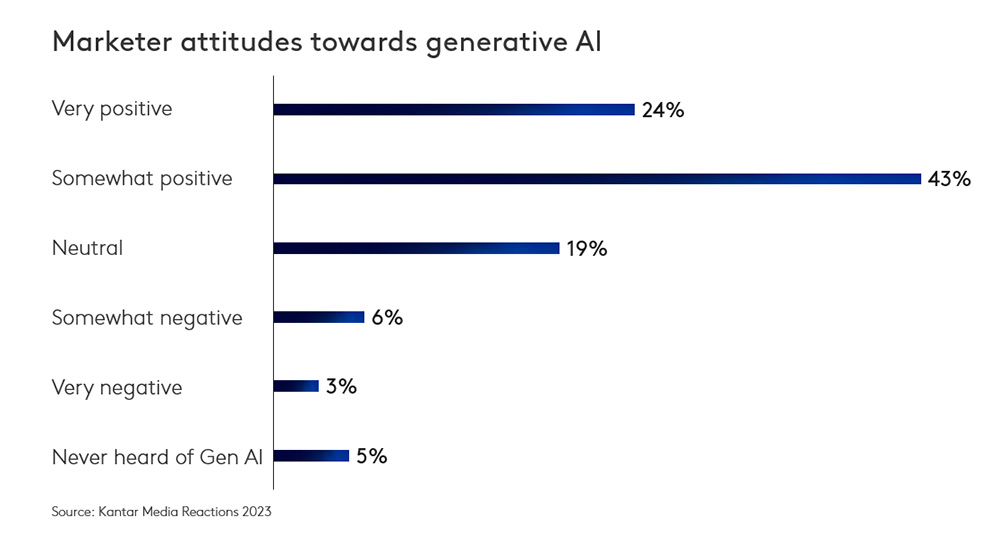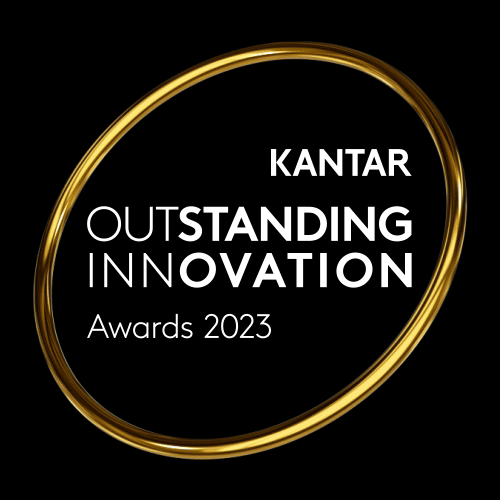A truly breakthrough innovation
Generative AI is one of the most profound innovations of our time; a truly breakthrough innovation enabling a step change in what we can achieve as humans. A recent study by Kantar highlights that while half of consumers are generally positive about generative AI, many are still neutral or unaware of it. Despite this many will have experienced the benefits, whether it is identifying an unfamiliar plant, turning ingredients into meals, or tracking their fitness.
This consumer ambivalence seems destined to change, as marketers have more positive attitudes towards AI and are eager to use the power of AI to deliver better and more personalised products and services.

The benefits of GenAI can spark opportunities for innovators, but as HBR puts it: “Generative AI’s greatest potential is not replacing humans; it is to assist humans in their efforts to create hitherto unimaginable solutions.”
Addressing the use of Generative AI in the innovation process, Shafik Saba, Global Lead of Front-End Innovation at Haleon, acknowledges the power of AI to synthesize vast amounts of information, but goes on to state:
“But where it gets really interesting with AI is that it can make connections that we wouldn't otherwise make, because it doesn't have the same biases that humans hold.”
He suggests that from an innovator’s perspective, generative AI offers huge potential to identify new opportunities, facilitate idea generation, and speed workflow.
“There is no doubt in my mind the positive impact AI is having on business, but it’s like learning a new language which can be hard, be less afraid of it and just start using everyday. ChatGPT, Firefly, Midjourney, whatever medium you work in just start playing to see what actually works for you and build capability in your teams.”
Temper excitement with thoughtfulness
Many companies are using AI to support innovation, but few are realising a positive impact.
For instance, 45% of those surveyed by BCG reported using AI to identify innovation themes, domains, adjacencies, and technologies, but only 13% claimed that they had realised impact from that implementation. (Source: BCG,2023)
AI can help spark imagination and creativity and facilitate processes, but innovators must remain accountable for the complex decision-making involved in which connections and opportunities resonate with clients and are aligned with your brand purpose.
Avoid the substitution effect
When a new technology emerges, organizations usually take a business perspective, as opposed to a consumer first perspective on how best to deploy it. Known as the substitution effect this is the idea that you do what you did before but leverage the technology to make it better. For example, with the introduction of cinematography initially movie halls only showed theatre pieces; only later discovering movie production could allow the recording of action in different moments and locations. Often the most valuable application of a technology is when it enables experiences that we did not do before (Verganti 2011)
Roberto Verganti, Professor of Leadership and Innovation, who we partner with from Stockholm school of economics told us:
“The real question for using generative AI is not how to substitute designers and make existing innovation processes faster. It is not simply about offering far greater ability to test at scale. It is about reinventing how we innovate. How, thanks to AI, can we make innovation processes more meaningful? Bring them closer to the real way people think creatively? Even bring innovation closer to consumption, so that products can be created when and where needs emerge, rather than being designed once and for all?”
Keep your innovation for humans with humans
For a pilot study of our new AI solution, we created a pair of concepts for the same proposition (an organic yogurt bar) where one was created by a human and the other by ChatGPT. We observed that ChatGPT doesn’t understand concept construction and piled on the benefits and reasons to believe whilst the human created a strong insight and supported it with a set of clear and concise benefits and reasons to believe. Our pilot AI tool demonstrated a 10% higher trial rate for the consumer generated concept.


Our study shows that AI-generated concepts can result in lower expected trial rates simply because AI can lack the understanding around a crucial consumer insight and resorts to loading up more benefits to provide what it thinks are better concepts.
This is why we believe that whilst AI and GenAI are important tools for innovators, some of their applications can't substitute consumer insight.
For example, the application of AI in concept testing can be a great opportunity for innovators, as it can offer valuable early top-level AI-generated feedback to help brands evaluate initial concepts. However, it does not preclude the need for in-depth exploratory research, or consumer-based evaluation, provided by Kantar’s ConceptEvaluate solution. This ensures that new concepts resonate with real people, and you can prioritise the most meaningful and different ideas and the ones most likely to drive incremental growth.
Balance openness with specificity
One of the most intriguing challenges of using AI is to find the optimal balance between opening up the opportunity to innovate and keeping appropriate guardrails in place.
On one hand, you do not want to train the AI too closely, because this will limit its ability to make new connections and identify previously unrecognized opportunities for innovation. So, to avoid confining the process to your own beliefs and experience, it is important to ask open questions, ones that will allow the AI to free range to identify new opportunities. As we noted in this article, significant growth potential is found in identifying blind spots, but if an AI lacks the relevant data or is trained too closely, it may not identify anything new.
This said, there is a risk in not defining the context for exploration properly; Shafik Saba, Global Lead of Front-End Innovation, at Haleon
“While unsupervised learning approaches inspire ideation, we should also explore supervised models where a brand needs to follow specific rules, we are seeing this in areas such as diagnostic digital healthcare experiences”.
So, the challenge is to balance unsupervised learning, allowing the machine to learn from data to make new insights and connections, but with human interpretation to ensure that new concepts are appropriate to your brand through expert fine tuning.
Seek meaningfully different ideas
The real opportunity is not generating more ideas, it is generating the right idea: one that will not just appeal to the target consumer, but which offers them a meaningful and different experience and allow the likeliness of brands to achieve market share growth by 2.5x. While the use of AI might speed up the innovation process, ultimately, there is no substitute for checking whether ideas and prototypes are perceived as meaningful and different to the intended audience.
Just because you can create something new using AI does not mean that you should. Brands like McDonalds, Baileys, and Guinness do not innovate randomly, they do so with clear incremental goals and with the intent that an innovation will build the brand for the long-term, not just short-term sales. To emulate their success, whatever you create must hold true to the essential qualities of your brand.
3 top tips to empower your innovation process through AI:
When it comes to using AI, Kantar has deep experience from working with clients and also from building AI into the solutions our clients use. With that in mind, we offer these three top tips on how to unlock the power of AI and create meaningfully different innovations.
- Embrace AI as part of a hybrid innovation process
Human expertise augmented by technology will give you the best outcomes. Think of AI as a smart, willing, and stimulating assistant. Encourage your innovation team to generate more and better ideas by combining human imagination with Generative AI to improve exploration of a solution space. Do not let AI blindly produce a thousand new concepts that might be relevant but not meaningful for your consumers, use your team’s creativity and imagination and industry expertise from business partners to guide it through the innovation process to find the right concept for your brand.
- Don’t forget the human experience
Your innovation must appeal to humans in all their glorious complexity. AI can only go so far in anticipating what people will find meaningful and will likely not be able to take context or emotions fully into account. Use a variety of research techniques to ensure a grounded understanding of what people really value and how they are likely to respond to your innovation. Ensure that you have a good understanding of the things that will help accelerate adoption (the fuels) and of the barriers that will hold adoption back or cause early users to lapse (the frictions).
- Don’t lose sight of meaningful difference
One of the biggest challenges in innovation – AI supported or not – is to avoid convergence where innovations across competitive brands risk ending up alike, leaving customers adrift in a sea of sameness. Balance openness with specificity to make sure that your AI-generated innovation offers something new, meaningful, and different. Lacking functional differentiation, think about how design can make your brand look distinctive, AI can help with that too. Keep the need to be different and distinctive in mind throughout the development process and test concepts and prototypes with the intended audience to ensure your innovation will stand out from the crowd in ways that are meaningful to them.
In conclusion, there is no doubt that Generative AI can be a powerful new tool in the innovator’s toolset. Used appropriately, it can identify previously hidden opportunities, combine ideas, and make new connections. However, there are pitfalls to be avoided to ensure that AI is used appropriately during your innovation process to produce meaningfully different products and services that resonate with your customers and consumers.
This is the last article in the Connected Innovation series, but as we continue to support clients in their innovation journey, get in touch with our Innovation experts to learn more about how we help our clients leverage the AI capability and make an impact in their innovation journey through Kantar’s insights and expertise.
At Kantar we believe that those developing and deploying AI need to commit to adopt ethical and responsible AI practices such as being ethical, accountable, transparent, equitable, resilient and compliant. For more information about the implications and opportunities of AI, please visit: www.kantar.com/artificial-intelligence.



